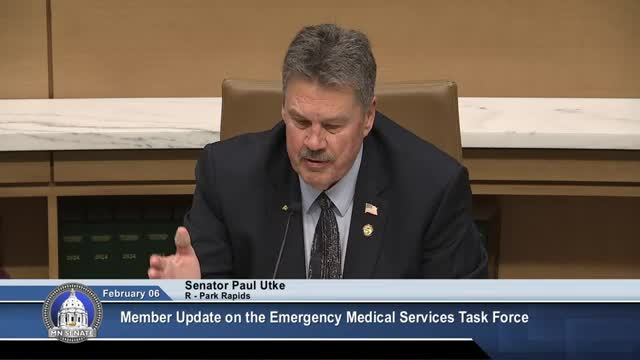Otter Tail and Grant Counties launch West Central Sprint Paramedic Pilot Program
February 06, 2025 | 2025 Legislature MN, Minnesota
This article was created by AI summarizing key points discussed. AI makes mistakes, so for full details and context, please refer to the video of the full meeting. Please report any errors so we can fix them. Report an error »

Rural emergency medical services (EMS) are facing a critical funding crisis, as highlighted in a recent Minnesota Senate Committee on Health and Human Services meeting. The discussion centered on the urgent need for support for volunteer-led ambulance services in Otter Tail and Grant Counties, where financial strains threaten their operations.
Becca Hubish, Director of Emergency Medical Services for Perham Health, presented the West Central Sprint Paramedic Pilot Program, designed to address these challenges. With five out of nine local ambulance services being volunteer-based, the community has been subsidizing operations to the tune of approximately $1.5 million annually in volunteer labor alone. This financial burden is compounded by the fact that many calls for service are not reimbursed, leaving local governments to shoulder the costs.
The pilot program aims to innovate the current EMS model by introducing advanced life support (ALS) capabilities through "sprint paramedics." These paramedics will be strategically deployed in rural areas to reduce response times and improve care for patients experiencing emergencies, such as heart attacks or strokes. The initiative is expected to enhance the sustainability of local services while also allowing basic life support (BLS) agencies to retain more revenue from calls.
Hubish emphasized the importance of addressing the needs of frequent callers—individuals who often rely on emergency services for non-emergency situations. The program will enable sprint paramedics to engage with at-risk populations, providing preventative care and reducing unnecessary 911 calls.
The committee members expressed strong support for the pilot program, recognizing its potential to alleviate some of the financial pressures on rural EMS. As the program gears up for implementation, it is anticipated to begin operations by the end of the month, with ongoing data collection to assess its effectiveness.
This initiative represents a significant step toward ensuring that rural communities receive the emergency medical care they need while also addressing the financial sustainability of the services that provide it. The outcome of this pilot could serve as a model for other regions facing similar challenges across Minnesota.
Becca Hubish, Director of Emergency Medical Services for Perham Health, presented the West Central Sprint Paramedic Pilot Program, designed to address these challenges. With five out of nine local ambulance services being volunteer-based, the community has been subsidizing operations to the tune of approximately $1.5 million annually in volunteer labor alone. This financial burden is compounded by the fact that many calls for service are not reimbursed, leaving local governments to shoulder the costs.
The pilot program aims to innovate the current EMS model by introducing advanced life support (ALS) capabilities through "sprint paramedics." These paramedics will be strategically deployed in rural areas to reduce response times and improve care for patients experiencing emergencies, such as heart attacks or strokes. The initiative is expected to enhance the sustainability of local services while also allowing basic life support (BLS) agencies to retain more revenue from calls.
Hubish emphasized the importance of addressing the needs of frequent callers—individuals who often rely on emergency services for non-emergency situations. The program will enable sprint paramedics to engage with at-risk populations, providing preventative care and reducing unnecessary 911 calls.
The committee members expressed strong support for the pilot program, recognizing its potential to alleviate some of the financial pressures on rural EMS. As the program gears up for implementation, it is anticipated to begin operations by the end of the month, with ongoing data collection to assess its effectiveness.
This initiative represents a significant step toward ensuring that rural communities receive the emergency medical care they need while also addressing the financial sustainability of the services that provide it. The outcome of this pilot could serve as a model for other regions facing similar challenges across Minnesota.
View full meeting
This article is based on a recent meeting—watch the full video and explore the complete transcript for deeper insights into the discussion.
View full meeting
